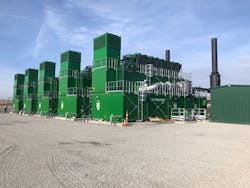The EnergyTech Mission Critical Microgrid Series Part 2: The Pittsburgh International Airport Microgrid
(Editor’s Note: This is one of a three-part EnergyTech series on Mission Critical Microgrids. See links to the other reports at the bottom of this story).
-- -- --
Microgrids are chameleons in that they can take on different looks and deploy different resources. They are the same species, but often distinct in reflection of their location and function.
Some are solar and battery storage only. Many, if not all, have generator-sets as backup or mainstay power, and those can run on natural gas or diesel. Some island from the grid although a few will not.
What all microgrids have in common is purpose. They are there for the mission critical, whether it’s land, sea or air.
The air travel industry is catching on to the resiliency attributes of the secure, wholly contained power generation system. Most have had on-site power gen-sets, but only a few are evolving to capture 100 percent resiliency and greenhouse gas reduction goals in one package.
One of the newer airport microgrids is in western Pennsylvania. The 8,800-acre Pittsburgh International Airport (PIA) has been important for a long time, offering nonstop service to more than 60 other airports and moving millions of customers annually.
One thing it didn’t have was energy backup resiliency, security, sustainability or singularity.
Those omissions were corrected about 10 months ago when the Pittsburgh International Airport Microgrid entered into operation. The combination of a gas-fired generator energy plant and a solar photovoltaic array has been a world changer for the facility.
“We are generating 100% of the electricity required to operate the airport,” Tom Woodrow, P.E., senior vice president for Engineering and Intelligent Infrastructure at the PIA, said in an exclusive interview with EnergyTech. Since the 2021 startup on through earlier this year “we have generated and consumed over 70 million kilowatt hours (kWh) from the microgrid. We’re averaging about 7.8 million kWh per month.”
The Most Focused Microgrid Conference? Microgrid 2022 in Philadelphia
Happening June 1-2. Details, agenda and registration here
The PIA Microgrid is built for resilience and sustainability, but is different from the solar-storage combinations being built in California and other places. The 20-MW energy plant is driven by five 4-MW Jenbacher engines for primary, baseload generation, delivering power to the airport-owned main service area, which includes the airfield, airside and landside terminals, the Hyatt Hotel, parking lots, and the 7-11 gas station.
Natural gas was the natural choice considering the resource-rich region where the Pittsburgh Airport resides.
“We are sitting on the top of the Marcellus and the Utica,” Woodrow pointed out, referring to two of the nation’s biggest shale plays for natural gas. “ The gas that feeds the generators is sourced directly from 12 Marcellus wells located on airport property. That’s a big part of our story.”
The nearby 3-MW solar array services 23 additional airport meters, but primarily is used as a net metering tool which discharges into the main grid connection with utility Duquesne Light.
Peoples Natural Gas owns the energy plant and they hold a ground lease for both the energy plant and the solar array. IMG Energy Services contracts with Peoples to operate the energy plant facility and they also own and operate the solar array. The solar array does not include battery storage.
“We had a vision of what a microgrid would look like here,” Woodrow said. “When we put it out for bid we said we have four main goals: increase the resiliency and reliability of power to the airport; lower the cost of electricity to the tenants and the airport authority; support the local natural gas industry and support our sustainability goals.”
On the first goal, the gas and solar microgrid combination is able to deliver far more power than the airport uses, so it reduces costs by both cutting out utility rates and by net metering the solar into the main grid. On the second, fiscal goal, it’s estimated the system will save at least $1 million in 2022.
The project certainly meets the third goal of supporting the local natural gas industry and on the final goal, Woodrow noted that the microgrid is forecast to reduce emissions by about 8.2 million pounds of carbon dioxide per year within the region, compared with previous power generation discharge.
The unexpected problems have been surprisingly few and far-between and mostly came early in the operational startup phase. For example, “the people mover train draws a heavy load each time so we needed to learn how to balance the system to deal with the high spikes in electricity demand,” Woodrow said.
“We were bringing in a little bit of grid power initially to balance the system but now the energy plant and control system is able to handle those momentarily upticks in load.”
The adaptability of the Pittsburgh International Airport Microgrid seems to be a resiliency tool worthy of the Steel City.
Read the rest of our EnergyTech Mission Critical Microgrids Series.
The Redwood Coast and Coast Guard Air Sector Humboldt Bay Microgrid
Microgrids for War Zones and Emergency Rooms
-- -- --
(Rod Walton, senior editor for EnergyTech, is a 14-year veteran of covering the energy industry both as a newspaper and trade journalist. He can be reached at [email protected]).





